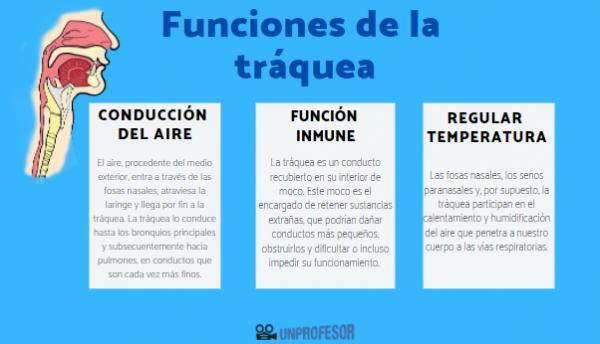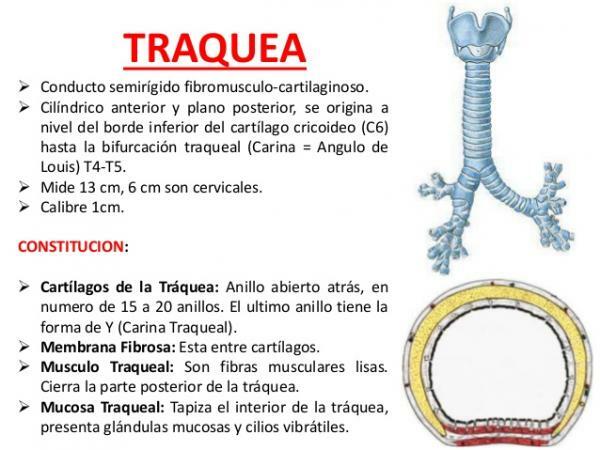Function of the main and secondary TRACHEA

The respiratory system It is made up of a variety of organs and structures. One of them, which normally goes unnoticed, is the trachea. Normally the trachea is described as a tube, whose only function is the conduction of air, but as we will see later, the trachea also has other functions.
If you want to know more about the function of the trachea in the human bodyWe invite you to continue reading this lesson from a TEACHER!
Index
- What is the trachea?
- Main function of the trachea
- The trachea as part of the immune system
- The trachea and thermoregulation
What is the trachea?
The windpipe is part of respiratory system and it is the conduit that communicates the larynx with the main or primary bronchi. That is why it has an inverted "Y" shape, since it connects the final part of the larynx, the cricoid cartilage, with the right and left bronchi. Within the conduction structures of the respiratory system, the trachea is encompassed within the extrapulmonary conduction structures.
In humans this duct measures 10 to 15 cm in length and is about 2.5 cm in diameter. The inner part of the trachea is lined with mucus, which prevents the entry of foreign substances from the outside to the pulmonary bronchi.
In addition, it is C-shaped (with the part open towards the back of the neck) and is made up of hyaline cartilage, which In addition to giving body to the structure, it allows it to have adequate flexibility to perform its function with normal.

Image: Slideshare
Main function of the trachea.
The main function of the trachea is to conduction of air during the breathing process. The air, coming from the external environment, enters through the nostrils, crosses the larynx and finally reaches the trachea. The trachea leads it to the main bronchi and subsequently to the lungs, in tubes that are increasingly thin.
Respiration consists of two stages: inspiration or air inlet and expiration or air outlet. During inspiration, the trachea widens in diameter and increases in length, to allow a greater entry of air and adequate air flow. On the other hand, during expiration, the trachea returns to its normal condition, that is, it reduces its diameter and length, leaving space for other adjacent structures.
Although the main function of the trachea is the conduction of air, from the larynx to the pulmonary bronchi, during the same the trachea is designed to carry out secondary functions, equally important.

Image: Slideshare
The trachea as part of the immune system.
As we have already advanced previously, the trachea is a conduit covered inside with mucus. This mucus is responsible for retaining foreign substances, which could damage smaller ducts, clog them and hinder or even prevent their operation. Therefore, the function of the trachea also has an immune component.
When irritants appear in the trachea, the cells that line the trachea are activated. This occurs because they are hair cells, that is, they have extensions of their cell wall. This means that the trachea is not a simple conduit, like a pipe, but seen under the microscope, its internal part is covered with extensions as if it were a brush or a mat. The movement of these cilia due to the appearance of the foreign substance triggers the cough reflex by contraction of the smooth muscles associated with it. Contraction of the smooth muscles of the trachea leads to a reduction in the diameter of the trachea and, together with the violent contraction of the muscles expiratory and the abrupt opening of the glottis, helps to increase the speed of the air flow to the outside and the elimination of substances irritants.
The cough allows, through an explosive air current, remove foreign substance and prevent damage from “downstream” structures, such as the pulmonary alveoli. Cilia sweep away particles that can be very small (2-10 μm). The ciliary mechanism is so powerful that it is capable of moving the particles at a speed of 16 mm per second.
This, together with the production of mucus, causes the structures of the upper part of the respiratory tract (from the nasal cavities, paranasal sinuses, larynx, etc.) to create a true particle and substance filters, which purify the air that comes from outside, loaded with irritating particles, and has to reach our pulmonary alveoli.
The trachea and thermoregulation.
As part of the upper respiratory system, the trachea also has the function of thermoregulation, that is, to keep the body temperature more or less stable. Despite not being the main thermoregulatory structure, the thermoregulatory function of the trachea is also very important.
The nasal passages, sinuses and, of course, the trachea are involved in the air heating and humidification that penetrates our body to the respiratory tract. This is achieved primarily by saturating the incoming air with water vapor. This humid air can now be heated more easily by exchanging heat with the structures inside our body.
If not heated, the air that enters our body during cold days would cause body temperature to drop below levels adequate, being able to produce complications, that some respiratory structures do not work properly and even the appearance of hypothermia.

If you want to read more articles similar to Function of the trachea, we recommend that you enter our category of biology.
Bibliography
- Ganong, W. F. (1980). Manual of medical physiology.
- Gartner, L. P., & Hiatt, J. L. (2006). Color textbook of histology ebook. Elsevier Health Sciences.
- Megías M, Molist P, Pombal MA. (2019). Atlas of plant and animal histology. Animal organs. Recovered from: http://mmegias.webs.uvigo.es/2-organos-a/guiada_o_a_inicio.php
- Parada Puig, R (s.f) Trachea: characteristics, functions, parts, histology, diseases. Leader. Recovered from: https://www.lifeder.com/
- Iglesias Ramírez, B Z. (September 2011). Complementary materials from the Histology Department. ICBP ”Victoria de Girón” Recovered from http://www.sld.cu/



